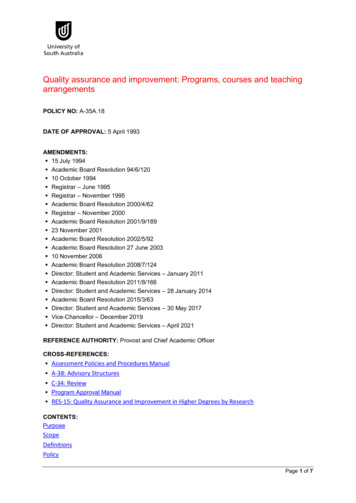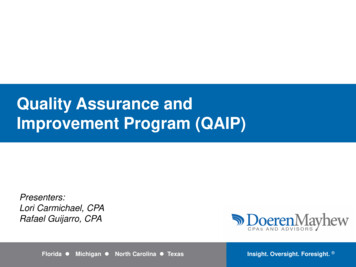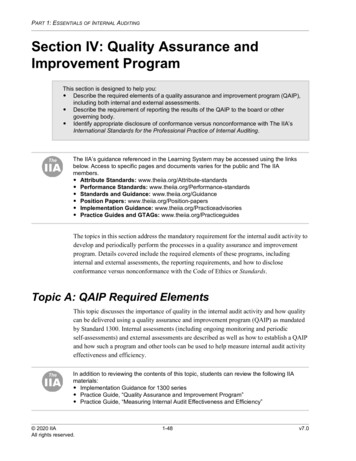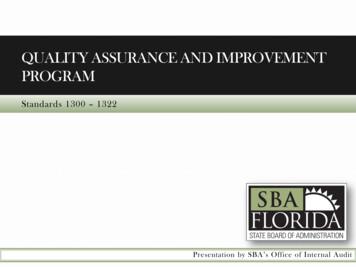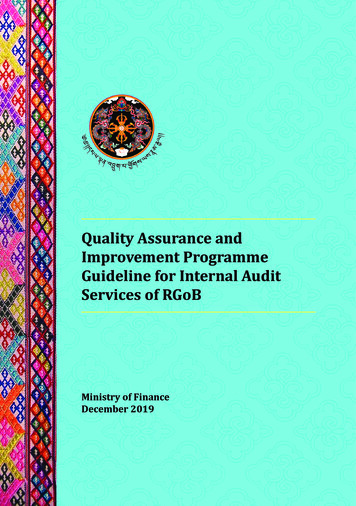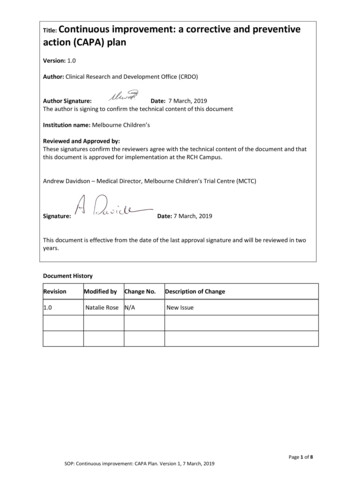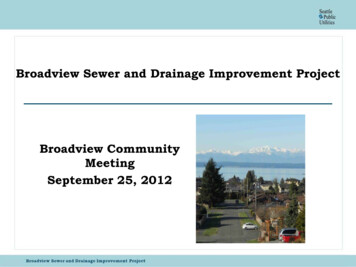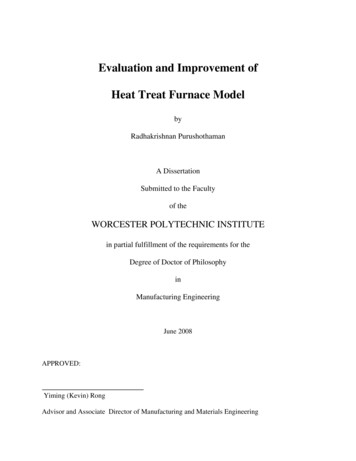
Transcription
Evaluation and Improvement ofHeat Treat Furnace ModelbyRadhakrishnan PurushothamanA DissertationSubmitted to the Facultyof theWORCESTER POLYTECHNIC INSTITUTEin partial fulfillment of the requirements for theDegree of Doctor of PhilosophyinManufacturing EngineeringJune 2008APPROVED:Yiming (Kevin) RongAdvisor and Associate Director of Manufacturing and Materials Engineering
ABSTRACTHeat treating is the controlled heating and cooling of a material to achieve certainmechanical properties, such as hardness, strength and the reduction of residual stresses. Manyheat treating processes require the precise control of temperature over the heating cycle.Typically, the energy used for process heating accounts for 2% to 15% of the total productioncost. The objective of this work is to develop a comprehensive furnace model by improving thecurrent Computerized Heat Treatment Planning System (CHT) based furnace model toaccurately simulate the thermal profile of load inside the furnace. The research methodology wasbased on both experimental work and theoretical developments including modeling differenttypes of heat treat furnaces. More than 50 experimental validations through case studies usingthe current CHT model were conducted in 11 manufacturing locations to identify the specificproblems in the current model. An enhanced furnace model based on Knowledge Data Discovery(KDD) technique and neural network is developed and validated. The new model takes intoaccount the real time furnace parameters determined from the experimental data and accounts forfurnace deterioration and some of the complex gradients and heating patterns that exist inside thefurnace that is difficult to model.
ACKNOWLEDGEMENTThis dissertation describes the research I conducted at the Worcester Polytechnic Institute (WPI)from 2003 after obtaining my Master of Science in Manufacturing Engineering also at WPI. This workwould not have been possible without the support and help of many people here at WPI and from outside.First of all I want to thank my advisor Prof. Kevin Rong who is also my mentor. He was always availableand provided me with guidance, advice, support and inspiration. Im thankful to everyone in theManufacturing and Materials Engineering Program here at WPI. And over the years I had opportunity tointeract, share, learn and rejoice with almost everyone in the program. I would like to take thisopportunity to thank Prof. Richard Sisson, Prof. Diran Apelian, Prof. Satya Shivkumar, Prof. ChrisBrown, Ms. Sue Milkman, Ms Carol Garofoli, and Ms. Maureen Plunket for the support over the years.I would like to thank CAMLAB at WPI and the members for their help and support during mystay here in WPI and in CHT Software Development and also support in other projects. I would also liketo thank Prof. Jinwu Kang, Tshingua University, Dr. Zhang Lei and Dr Xubing Chen.The unique opportunity to meet the leaders in the industry, learn and solve technical problemsalong with them at Center for Heat Treating Excellence (CHTE) was the most valuable learningexperience for me at WPI. I would like to thank Metal Processing Institute, CHTE and CAT for thisopportunity and support. I would also like to thank all the member companies who helped this research byproviding the resources and facilities for this research. I like to thank American Heat Treating, CT; SousaCorporation, CT; Bodycote (Waterbury, CT; Berlin, CT; South Windsor, CT and Worcester, MA);Caterpillar, Peoria, IL; Queen city steel, Cincinnati, OH; Ipsen, Rockford, IL; and . I would like to thankMr. Max Heotzl of Surface Combustion who was an advisor and a champion for this project. Who spentnumerous hours with the research group assisting us solve several technical challenges. I also thankAdvanced Materials Technology Division at Caterpillar for the research internship opportunity at Peoria. Iwould like to thank my colleagues at Caterpillar Mr. Tom Clements, Mr. Randall Conklen, Mr. HaroldPlacher and Mr. Don Benckendorf for their help and insight for this project.Last, but not least, I want to thank my fiancée Neha Chandra for all her love and support and myparents for their continuous encouragement.
TABLE OF CONTENTSCHAPTERPageABSTRACT . iACKNOWLEDGMENTS . iiTABLE OF CONTENTS . iiiLIST OF FIGURES . viLIST OF TABLES . xiCHAPTER 1 – Introduction . 11.1 Objectives and scope of study1.2 Dissertation organizationCHAPTER 2 – Background and literature review . 42.1 Heat treating process overview . 42.2 Types of furnaces . 82.3 Furnace heat input . 122.4 Furnace control . 172.5 The need to model furnaces . 182.6 Current research . 192.7 Current software tools. 192.8 The Summary . 22CHAPTER 3 – CHT furnace model . 233.1 Overview of current CHT furnace model . 233.2 Furnace Energy Balance Model . 263.3 Heat Transfer model . 353.4 Furnace temperature control model. 423.5 Summary . 47CHAPTER 4 – Furnace model analysis . 484.1 Furnace model study . 494.2 Problem identification in the current CHT furnace model . 524.3 Summary & Conclusions . 54iii
CHAPTER 5 – Improved furnace model . 555.1 Introduction . 555.2 The door open model. 575.3 The furnace gradient model . 695.4 Virtual load design and calibration . 865.5 Conclusion . 91CHAPTER 6 – Knowledge data discovery based furnace model . 926.1 Furnace calibration model . 986.2 User defined item. 1056.3 KDD auto-learning classification model . 1056.4 Tuning model and procedure . 1086.5 Summary & Conclusions . 108CHAPTER 7 – Summary . 109REFERENCES . 111Appendix A – Case Studies . 117iv
LIST OF FIGURESPage No2.1 - Energy Source Breakdown for Key Industrial Process Heating Applications . 52.2 – A typical heat treatment cycle for a typical carburizing process with a reheatcycle . 52.3 – Furnace Classification . 82.4 - A schematic of Batch–Integral furnace . 102.5 - Pusher-type and rotary-hearth heat-treat system . 112.6 - Schematic of the indirect-fired section of the Inland Steel annealing furnace . 122.7 - Variations in the furnace thermal efficiencies with load and refractoryemissivities (left) & Variations in the load and roof surface temperatureswith distance for varying load emissivities (right) . 132.8 - Variations in the load and crown surface temperatures with distance fordifferent radiant-tube designs in the furnace . 142.9 - A typical pusher-type direct fired furnace: (a) longitudinal section,(b) transverse section . 152.10 – (a) A comparison of model predictions for steel temperature and plant data atbetween-skid thermocouple locations. (b) A comparison of model predictions for steeltemperature and plant data at over-skid thermocouple locations . 162.11 – Comparison of the thermocouples with the thermal imaging system and thethermal gradient inside the box type furnace . 172.12 - Impact of production rate on energy consumption per unit of production . 182.13 - The load pattern for continuous belt in FurnXpert software . 202.14 - The result illustration of FurnXpert software . 213.1 - Key components of a process heating system . 233.2 - Flowchart for temperature calculation of loaded furnace . 253.3 - Schematic of a heat balance in a batch furnace. . 27vi
3.4 - Schematic of a heat balance in a continuous furnace . 313.5 - Factors that affect the furnace temperature . 363.6 - Loads in a heat treating furnace . 363.7 - The factors affecting the workpiece temperature . 373.8 – The equivalent workpiece . 393.9 - Schematic of the Temperature controller in a radiant tube type furnace . 423.10 - On/Off & Proportional type controllers commonly used in furnaces . 433.11 - Control feedback loop of PID control . 455.1a - The thermal gradients inside a Continuous Pusher Furnace, experimentaldata from continuous datapak with 6 thermocouples. . 555.1b - The thermal profile of the CHT calculated and measured workpiecetemperature at 6 different locations in a Continuous Furnace . 575.2 - Pusher type Continuous Furnace Model. 585.3 - Door open/ Push sequence in a Continuous Furnace Model . 605.4 - Empirical data used by a furnace manufacturer based on experiments andexperience to predict the loss of atmosphere during the door operation in acontinuous furnace . 615.5 - The pressure in two different final zones in a Continuous Pusher Furnace . 625.6 - The pressure variations as a function of different door operations eventsHolding Chamber (left) & Quench Chamber (right) . 635.7 - The door open schedule based on the furnace layout represented in thetime domain. 645.8 - The screen shot of the furnace thermal profile computed by CHT-c/fsoftware using the improved furnace model . 665.9 - The comparison of the furnace thermal profile computed using improvedfurnace model and measurement results. . 67vii
5.10 - The thermal gradients inside a batch type heat treating furnace . 695.11 - Furnace temperature gradients and gradient variations in a fully loadedfurnace over a period of 40 minutes in a Continuous Pusher type.Carburizing Furnace with a push cycle time of 16 minutes. . 705.12a - Experimental setup showing the datapak and thermocouple locationsinside the Pusher Furnace. . 725.12b - The thermal gradients inside a Continuous Pusher Furnace, experimentaldata from continuous datapak with 6 thermocouples. . 725.13 - Temperature gradient between the set point temperature and the workarea (center of furnace) at 3 different zones and locations in a Rotary typeContinuous Furnace . 735.14 - Different burner patterns / schemes commonly used in the Pusher TypeContinuous Furnaces .
Heat Treat Furnace Model by Radhakrishnan Purushothaman A Dissertation Submitted to the Faculty of the WORCESTER POLYTECHNIC INSTITUTE in partial fulfillment of the requirements for the Degree of Doctor of Philosophy in Manufacturing Engineering June 2008 APPROVED: Yiming (Kevin) Rong Advisor and Associate Director of Manufacturing and Materials Engineering . ABSTRACT Heat


